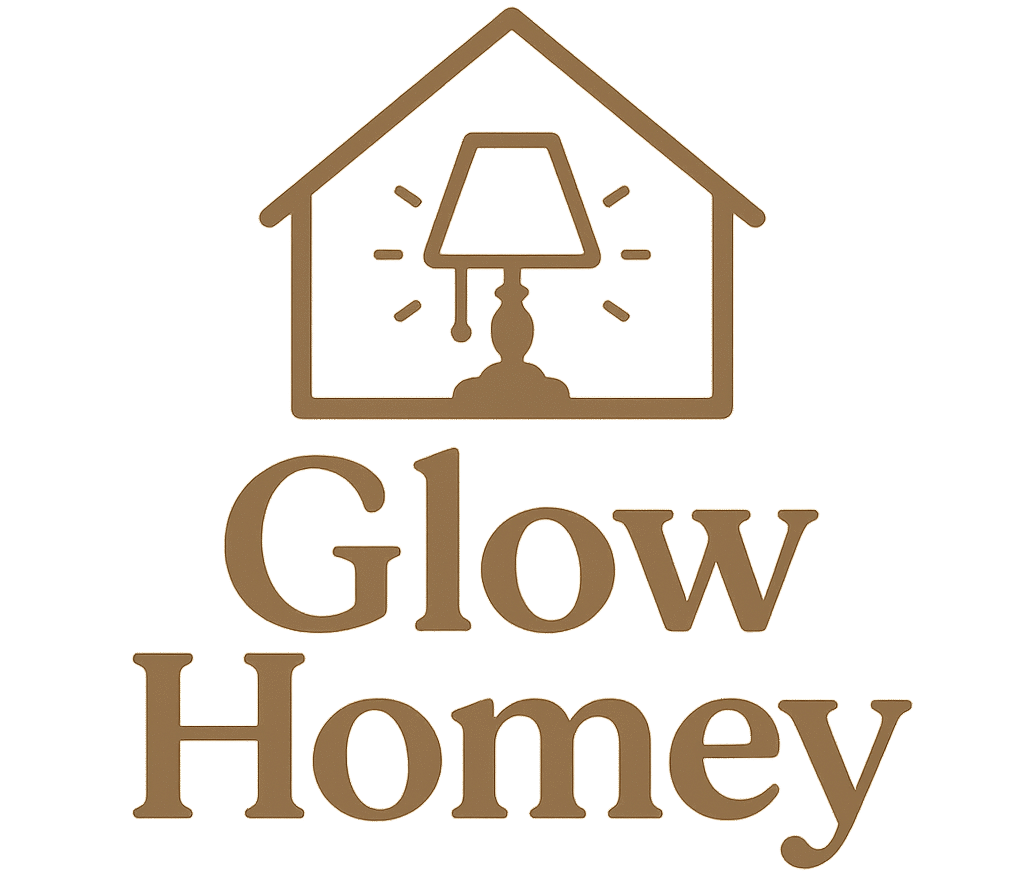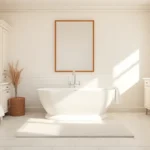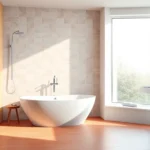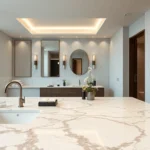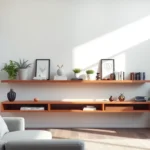Transform your daily routine with stunning shower tile designs that turn your bathroom into a personal spa retreat. We’ve all experienced that moment when we step into someone else’s beautifully tiled shower and wonder why our own feels so bland and uninspiring.
The right tile choice doesn’t just protect your walls from moisture – it creates the entire mood and aesthetic of your bathroom space. From sleek subway tiles that never go out of style to bold geometric patterns that make a statement, we’ll explore design ideas that work with any budget and bathroom size.
Whether you’re planning a complete bathroom renovation or simply looking to refresh your shower area, we’ve gathered the most popular and practical tile design trends that’ll help you create a space you’ll actually look forward to using every morning.
Classic Subway Tile Patterns for Timeless Appeal
Subway tiles remain the gold standard for shower designs that never go out of style. We’ll explore three fundamental arrangements that elevate your shower space while maintaining that coveted timeless aesthetic.
Traditional Horizontal Layout
Running subway tiles in horizontal rows creates the most recognizable and versatile pattern for shower walls. We recommend using 3×6 inch white ceramic subway tiles with dark grout lines to achieve that authentic vintage appeal. This classic arrangement works exceptionally well in smaller shower spaces since the horizontal lines make walls appear wider and more spacious.
Installing tiles with a standard running bond pattern means each tile centers over the joint of tiles below it. We suggest keeping grout lines at 1/8 inch width to maintain clean proportions. Popular color combinations include white tiles with charcoal grout or cream tiles with light gray grout for subtle contrast.
Vertical Stacking for Height
Stacking subway tiles vertically transforms your shower into a taller appearing space that draws the eye upward. We often use this technique in showers with standard 8 foot ceilings to create dramatic height illusion. The vertical orientation works particularly well behind shower niches and soap ledges.
Installing tiles in straight vertical columns rather than offset patterns creates bold contemporary lines. We recommend using larger format subway tiles like 4×12 inches for vertical installations to reduce grout line frequency. Light colored tiles with matching grout maintain the clean modern aesthetic this pattern delivers.
Herringbone Pattern Variation
Arranging subway tiles in herringbone creates sophisticated texture while maintaining classic appeal. We love this pattern for accent walls or shower floors where slip resistance matters. The zigzag arrangement adds visual interest without overwhelming smaller shower spaces.
Creating herringbone requires cutting tiles at 45 degree angles where they meet walls and fixtures. We suggest hiring experienced installers for this pattern since precise measurements prevent costly mistakes. Neutral subway tiles in bone or dove gray work beautifully with herringbone layouts for understated elegance.
Bold Geometric Designs to Make a Statement
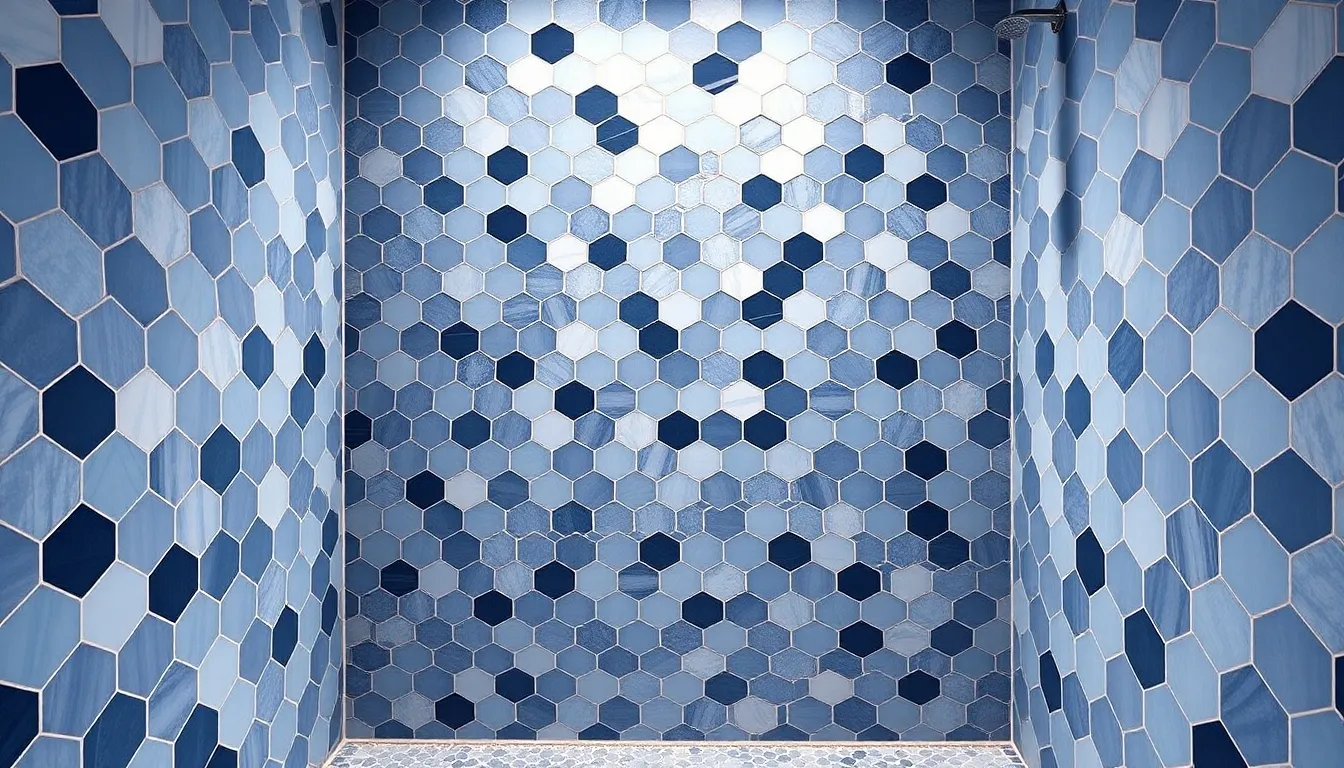
Graphic patterns featuring bold geometric shapes like triangles, squares, and circles bring modern sophistication to any shower space. Contrasting colors paired with these ever-changing designs create stunning focal points that transform ordinary bathrooms into contemporary retreats.
Hexagonal Tile Arrangements
Hexagonal tiles offer incredible versatility for creating unique and visually appealing shower designs. Standard hexagon patterns can be arranged as traditional honeycombs or reimagined as contrasting accent walls that draw the eye upward.
Ombre effects using hexagonal tiles create beautiful gradient transitions from light to dark tones throughout the shower area. We’ve seen this technique work exceptionally well with blues transitioning to whites or grays flowing into charcoals.
Mosaic hexagon arrangements combine multiple small hexagonal pieces to form larger geometric patterns. These intricate designs add texture and depth while maintaining the clean lines that make geometric patterns so appealing.
Diamond and Rhombus Patterns
Diamond shaped tiles create sophisticated and ever-changing visual interest in shower installations. These angular forms can be arranged in repeating patterns that stretch across entire walls or used strategically as accent pieces.
Rhombus configurations offer a slightly different take on the diamond concept with elongated proportions. We recommend using these shapes to create vertical emphasis in taller shower spaces or horizontal flow in wider installations.
Alternating diamond layouts combine different sized diamond tiles to create rhythm and movement. This approach works particularly well when mixing matte and glossy finishes for added dimensional contrast.
Chevron and Zigzag Layouts
Chevron patterns arrange rectangular or square tiles in distinctive V shaped formations that add modern energy to shower walls. This zigzag approach creates movement and visual interest while maintaining clean geometric lines.
Zigzag layouts use similar principles but offer more flexibility in tile orientation and spacing. We’ve found these patterns work best with contrasting grout colors that emphasize the geometric structure.
Ever-changing chevron arrangements can be oriented vertically to enhance height perception or horizontally to expand narrow shower spaces. The key lies in selecting the right tile proportions to achieve the desired visual impact.
Natural Stone Options for Luxury Feel
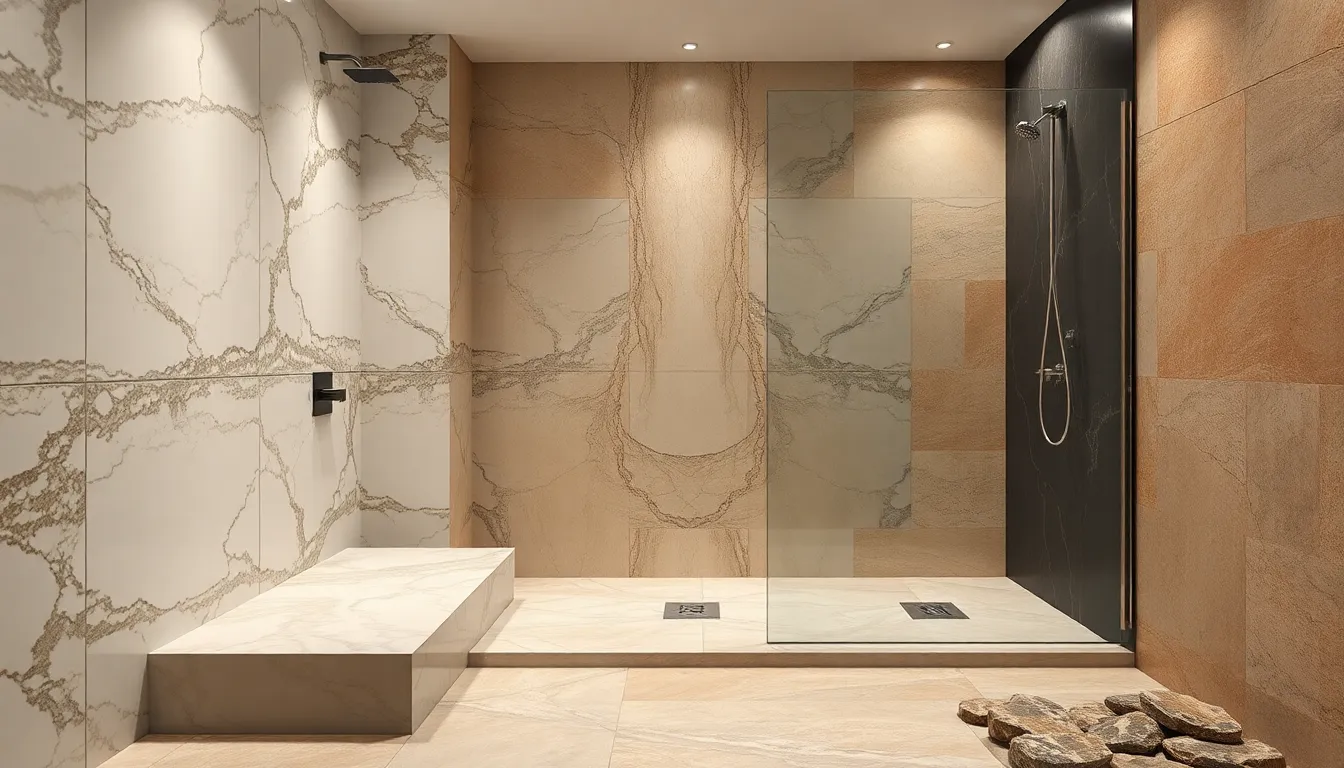
Natural stone tiles transform ordinary showers into luxurious spa-like retreats. We’ve compiled the most elegant stone options to elevate your shower design.
Marble Slab Installations
Marble stands as the ultimate choice for creating sophisticated shower spaces that exude timeless elegance. We recommend full marble tile installations that envelop your entire shower area with stunning organic veining patterns. These natural formations add incredible depth and visual interest to your walls while maintaining a cohesive luxury aesthetic.
Selecting the right marble type makes all the difference in achieving your desired look. Carrara marble offers classic white backgrounds with subtle gray veining, while Calacatta provides dramatic contrast with bold, thick veins. Statuario marble delivers the most luxurious appearance with its pristine white base and striking golden veining.
Installing marble slabs requires professional expertise to ensure proper sealing and longevity. We suggest using large format tiles to minimize grout lines and create a seamless appearance that maximizes the stone’s natural beauty.
Travertine Texture Combinations
Travertine brings warm, earthy textures that create inviting shower environments with natural charm. We love how this limestone variety offers unique surface variations that range from smooth honed finishes to tumbled textures with rounded edges. Its neutral color palette complements virtually any design scheme while adding organic visual interest.
Combining travertine with complementary materials creates stunning design contrasts. We recommend pairing travertine field tiles with marble borders for an elegant upgrade, or incorporating glass mosaics as accent strips to introduce light reflection. These combinations balance the stone’s natural texture with modern sophistication.
Choosing the right travertine finish affects both aesthetics and maintenance requirements. Polished travertine offers a sleek appearance but requires more careful cleaning, while brushed finishes provide better slip resistance for shower floors.
Slate and River Rock Accents
Slate provides sleek, dark finishes that create dramatic contrast and visual depth in shower designs. We use slate as accent tiles to break up lighter color schemes and add contemporary sophistication to traditional layouts. Its fine-grained texture offers excellent grip for safety while maintaining an upscale appearance.
River rock tiles bring organic elements that transform showers into natural spa environments. We often install these smooth, rounded stones on shower floors where they provide exceptional slip resistance and foot massage benefits. Their varied sizes and earth-tone colors create beautiful mosaic patterns that connect your bathroom to nature.
Strategic placement of these accent materials maximizes their visual impact. We recommend using slate as vertical accent strips or niche backgrounds, while river rock works best on floors or as feature walls behind shower benches.
Modern Large Format Tiles for Seamless Look
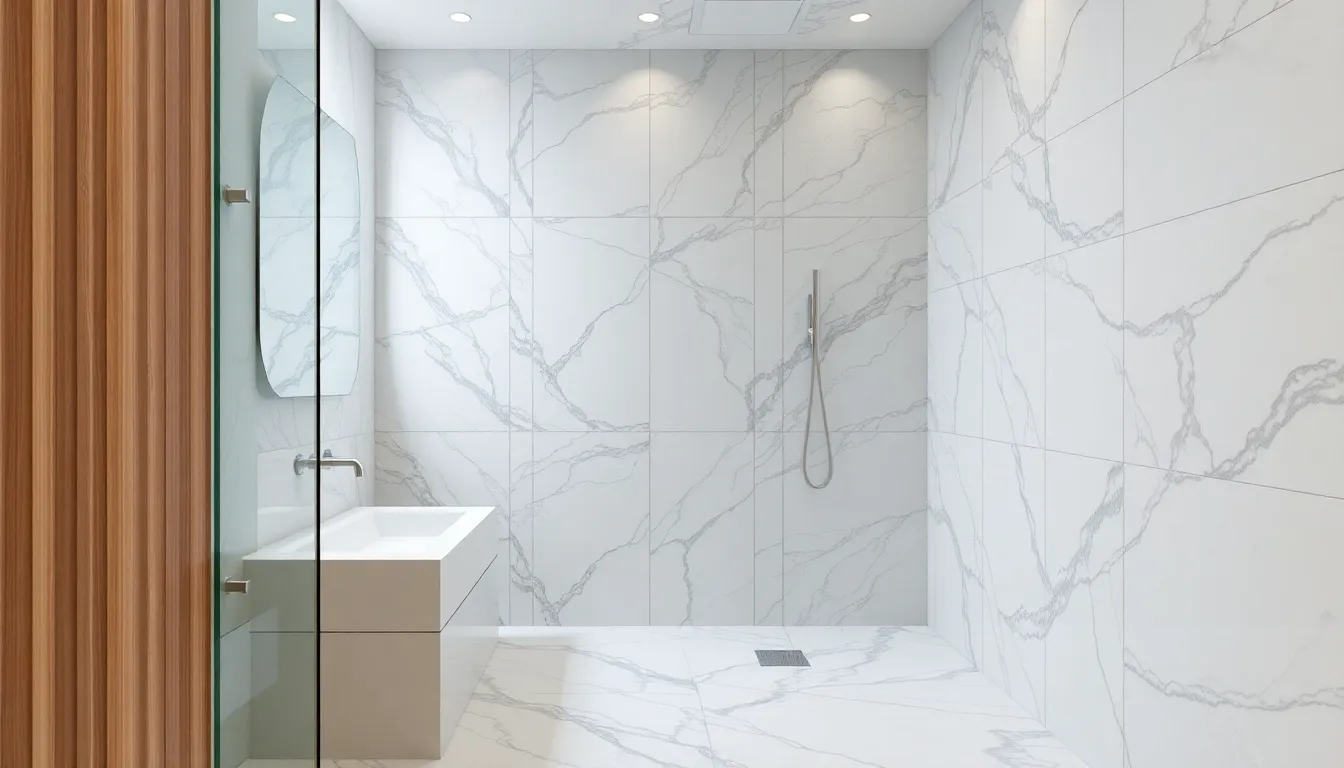
Large format tiles represent the pinnacle of contemporary shower design, offering uninterrupted surfaces that transform ordinary bathrooms into stunning architectural statements. We’re seeing homeowners increasingly choose these expansive tiles to create sophisticated, hotel-inspired shower spaces.
Floor-to-Ceiling Single Slabs
Single slab installations create the most dramatic visual impact in modern shower design. We recommend using porcelain slabs measuring 5×10 feet or larger to achieve this seamless effect from floor to ceiling. These massive installations eliminate grout lines entirely, creating continuous surfaces that make even compact showers feel expansive and luxurious.
Installation requires specialized equipment and experienced professionals due to the weight and size of these slabs. We’ve found that homeowners who invest in floor-to-ceiling installations often choose marble-look porcelain or natural stone patterns to maximize the dramatic veining effects. The uninterrupted surface allows these patterns to flow naturally, creating stunning focal walls that rival high-end spa environments.
Minimal Grout Line Designs
Grout line reduction becomes the primary benefit when we select large format tiles for shower applications. We typically recommend tiles measuring 24×48 inches or larger to minimize maintenance requirements while improving visual appeal. These dimensions significantly reduce the total grout area compared to traditional subway or mosaic installations.
Maintenance becomes substantially easier with fewer grout lines to clean and seal regularly. We’ve observed that large tiles help mask slight wall imperfections, creating smoother finished surfaces that appear professionally installed. The streamlined appearance works particularly well in minimalist design schemes where clean lines and uncluttered surfaces take precedence.
Oversized Rectangle Layouts
Rectangle configurations offer incredible versatility for creating custom patterns within modern shower designs. We recommend oversized rectangular tiles measuring 12×24 inches or 18×36 inches for optimal pattern flexibility. These proportions work beautifully in horizontal, vertical, or mixed installations depending on your space requirements.
Pattern options include contemporary brick layouts, sophisticated herringbone arrangements, or ever-changing mixed-size compositions. We’ve successfully combined large rectangular tiles with smaller accent pieces to create visual interest while maintaining the clean aesthetic that large format tiles provide. The rectangular shape naturally complements modern bathroom fixtures and creates cohesive design flow throughout the space.
Mosaic Tile Combinations for Visual Interest
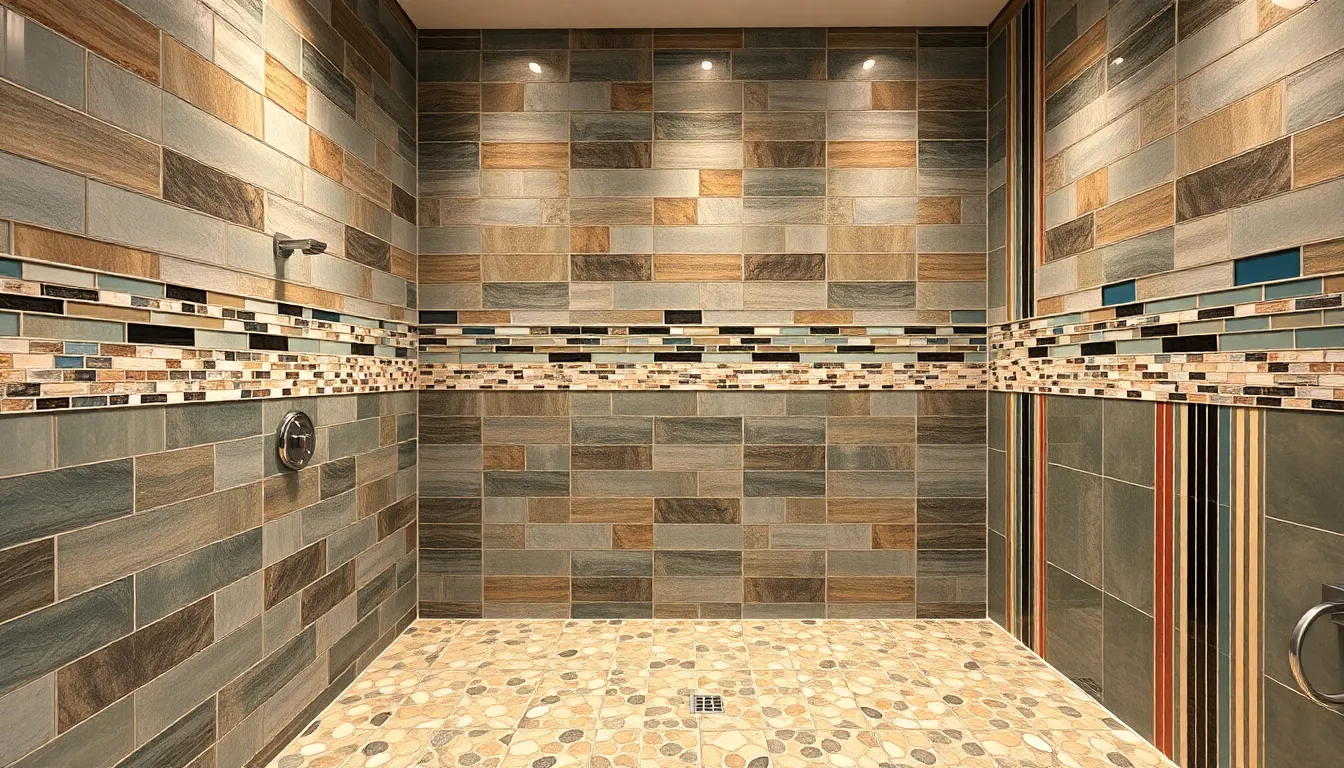
Mosaic tiles offer endless opportunities to create stunning visual focal points in your shower space. We’ll explore how mixing materials, colors, and placement techniques can transform your shower into a personalized masterpiece.
Glass and Stone Mixed Materials
Recycled glass tiles bring both glamour and environmental consciousness to your shower design. These sustainable options create brilliant light reflection when paired with natural stone materials, offering a unique visual appeal that standard tiles simply can’t match.
Marble look ceramic tiles paired with natural stone effect tiles deliver sophisticated elegance without the maintenance concerns of real marble. We recommend combining these materials in a 70/30 ratio, using marble look tiles as the primary surface and stone tiles as accent features.
Pebble stone mosaics create incredibly calming textures that transform your shower into a tranquil spa like retreat. These natural materials work beautifully when combined with glass accent tiles, particularly in earth tones that complement the organic pebble shapes.
Travertine and glass combinations offer warm, earthy foundations enhanced by sparkling glass highlights. Consider using larger travertine tiles as your base with glass mosaic strips creating geometric patterns or border accents throughout the design.
Gradient Color Transitions
Gradient color patterns achieve ever-changing visual movement by incorporating tiles in progressively different shades across your shower walls. Start with darker tones at the bottom and gradually transition to lighter shades near the ceiling for an elegant ombre effect.
Horizontal gradient layouts work particularly well in smaller shower spaces, creating the illusion of width while adding sophisticated color depth. We suggest using 2×2 inch mosaic tiles in 5 to 7 different shades to create smooth color transitions.
Vertical gradient installations enhance the perception of height in your shower while creating dramatic visual impact. Position the darkest tiles at floor level and gradually lighten the palette as you move upward, using consistent spacing for professional results.
Corner to corner gradients offer contemporary design answers that draw the eye across the entire shower space. This technique works exceptionally well with glass tiles that reflect light differently at various angles, improving the gradient effect.
Accent Strip Placements
Horizontal accent strips using contrasting materials create striking visual breaks in large shower walls. We recommend placing these strips at shoulder height or one third of the way up the wall for optimal visual balance and design impact.
Vertical accent strips add sophisticated height emphasis while creating natural divisions in shower spaces. Consider using these strips to frame shower niches or separate different functional areas within larger shower enclosures.
Geometric pattern integration allows accent strips to become focal points within herringbone or chevron tile layouts. These strips can follow the existing pattern lines or create deliberate interruptions that add design complexity and visual interest.
Penny tile mosaic accents provide vintage inspired charm when used as border strips or feature panels. These small, rounded tiles can be arranged in countless patterns, offering versatility that adapts to both traditional and contemporary shower designs.
Color Schemes That Transform Your Space
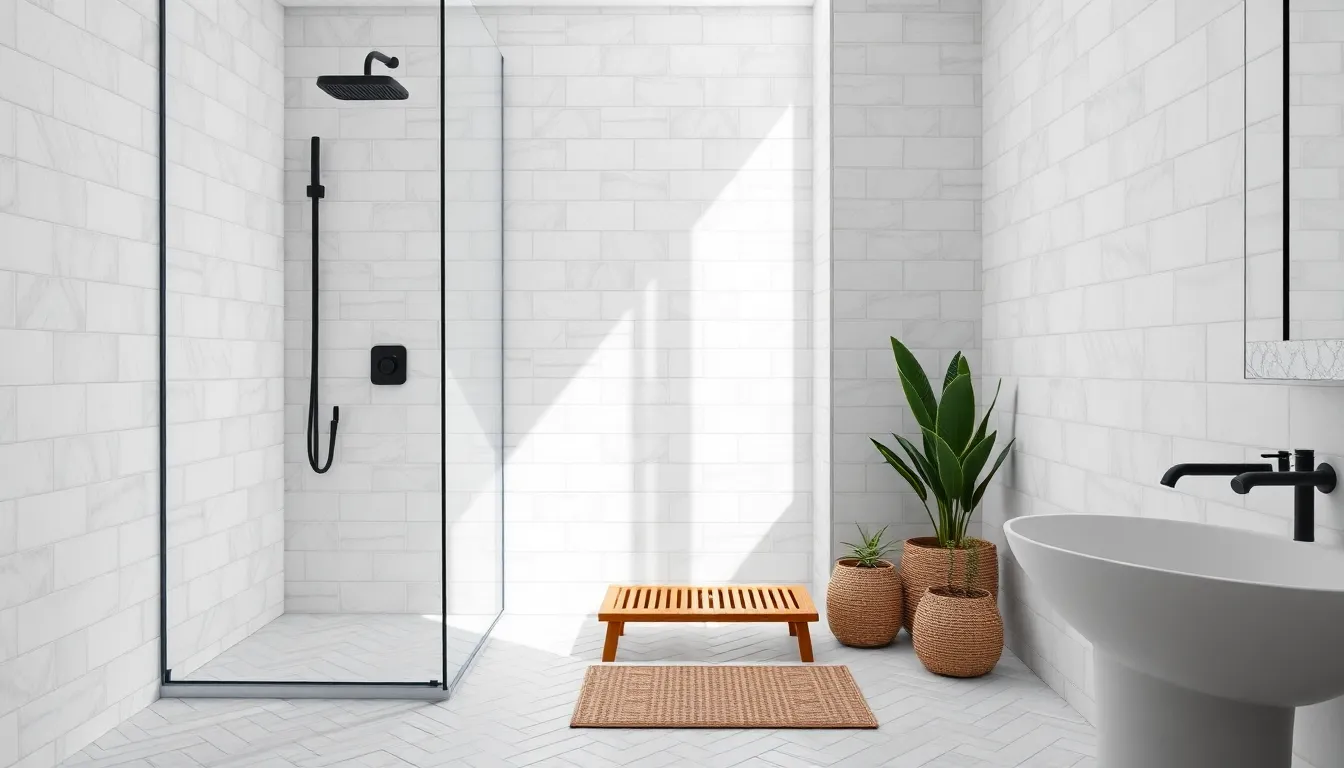
Color choices dramatically reshape your shower’s entire ambiance and visual impact. We’ll explore three groundbreaking color approaches that elevate any bathroom design.
Monochromatic Neutral Palettes
Neutral tones create calm, inviting, and timeless shower environments that never go out of style. White tiles offer endless adaptability, allowing you to arrange them in classic subway patterns, vertical layouts, or sophisticated herringbone designs that add subtle texture without overwhelming smaller spaces.
Soft grays and beiges provide versatility for both modern and traditional bathroom styles. These neutral foundations work beautifully with soft patterns like floral or fern motifs in muted tones, adding visual interest while maintaining a soothing ambiance throughout your shower area.
Small bathrooms benefit most from monochromatic neutral schemes because they create an illusion of expanded space. Clean lines and consistent color temperatures make these palettes ideal for designs that prioritize a fresh, modern aesthetic.
Bold Contrast Combinations
Strong contrasts make dramatic statements that instantly transform ordinary showers into striking focal points. Black and white combinations create maximum visual impact, especially when arranged in geometric patterns or bold tile stripes that define feature walls within your shower space.
Deep navy paired with white offers sophisticated drama without the stark intensity of pure black and white schemes. Grout color plays a important role in these bold designs, with dark grout highlighting each light tile to add depth and definition throughout the installation.
Ombre transitions provide luxury touches that can be achieved through contrasting tiles or carefully planned mosaic patterns. These gradual color shifts create movement and visual interest while maintaining the bold impact that makes your shower a true design statement.
Earthy Tone Selections
Earthy tones bring natural warmth and energy that transforms showers into spa-like retreats. Deep emerald tones evoke luxury and drama, creating sophisticated environments that feel both bold and naturally inspired.
Sage hues create serene, nature-inspired atmospheres perfect for daily relaxation and unwinding. Wood-look tiles offer contemporary alternatives that pair beautifully with mosaic accents and various pattern arrangements throughout your shower design.
Terracotta shades add Mediterranean warmth that works especially well in transitional and rustic bathroom styles. Mosaic or herringbone patterns in these earthy tones add texture and refinement, while well-placed shower niches provide functional storage that complements the natural aesthetic.
Balanced accents enhance earthy schemes without overwhelming the natural color palette. These warm, organic tones work particularly well in both modern and traditional spaces, offering versatility that adapts to various design preferences and architectural styles.
Textured Tile Ideas for Added Dimension
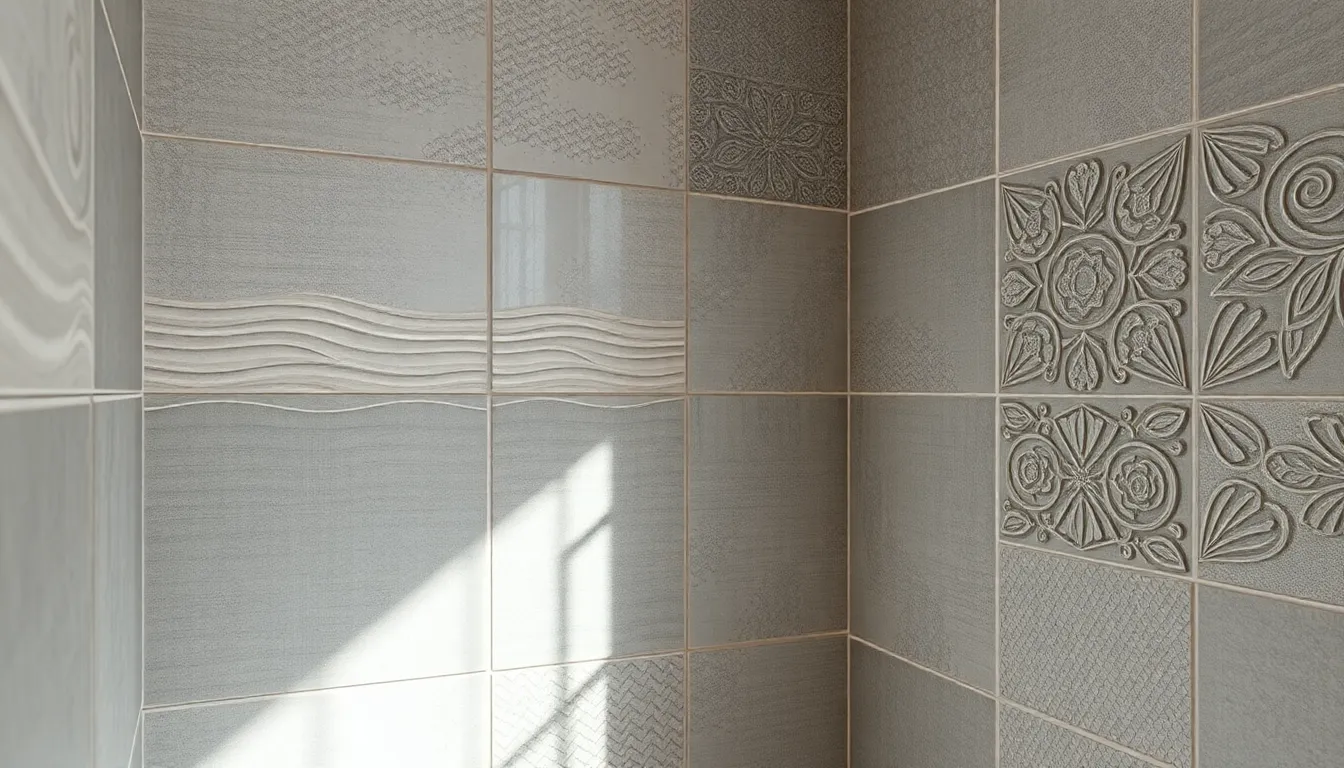
We’ve moved beyond flat surfaces to explore how texture transforms shower spaces into ever-changing environments. Adding dimension through textured tiles creates visual depth while improving the tactile experience of your daily routine.
3D Relief Patterns
Sculptural tiles featuring soft waves create captivating depth that draws the eye across shower walls. These dimensional elements work particularly well as accent walls behind the showerhead or along the back wall of walk-in showers. Geometric shapes in raised relief patterns offer modern sophistication while maintaining easy maintenance properties.
Intricate floral designs carved into ceramic or porcelain surfaces bring organic beauty to contemporary bathrooms. We recommend using these statement pieces sparingly to avoid overwhelming the space. Installing 3D relief tiles in shower niches or as feature strips creates focal points without compromising the overall design balance.
Wave patterns flowing horizontally across shower walls create movement that mimics water itself. These tiles work exceptionally well in larger shower spaces where the pattern can fully develop across multiple rows.
Brushed and Matte Finishes
Brushed finishes provide subtle texture that complements both modern minimalist and traditional design schemes. The gentle surface variation reduces glare from overhead lighting while creating visual interest through shadow play. These finishes work particularly well on large format tiles where the texture can be appreciated across broader surfaces.
Matte surfaces offer practical benefits beyond their aesthetic appeal. They hide water spots and soap residue better than glossy alternatives while providing better slip resistance. We suggest using matte finished tiles in neutral tones like warm grays or soft beiges to maximize their versatility.
Combining brushed and matte finishes within the same shower creates layered texture without introducing color complexity. Installing brushed tiles as accent strips against matte field tiles establishes visual rhythm while maintaining a cohesive appearance.
Raised Surface Designs
Moroccan inspired patterns featuring raised elements create dramatic contrast through strategic shadow placement. These designs work best when installed with proper lighting that emphasizes the dimensional qualities throughout different times of day. We recommend positioning these tiles where natural or accent lighting can highlight their sculptural properties.
Raised checkerboard patterns using colors like orange and white deliver chic sophistication with bold visual impact. The elevation changes between tiles create natural grout shadow lines that enhance the geometric precision. These patterns work exceptionally well in powder room showers or guest bathroom installations.
Dimensional hexagonal tiles with raised centers create honeycomb effects that add organic texture to modern shower designs. Installing these tiles in varying heights across the shower wall creates custom relief patterns customized to your exact space dimensions.
Mixed Material Approaches for Unique Style
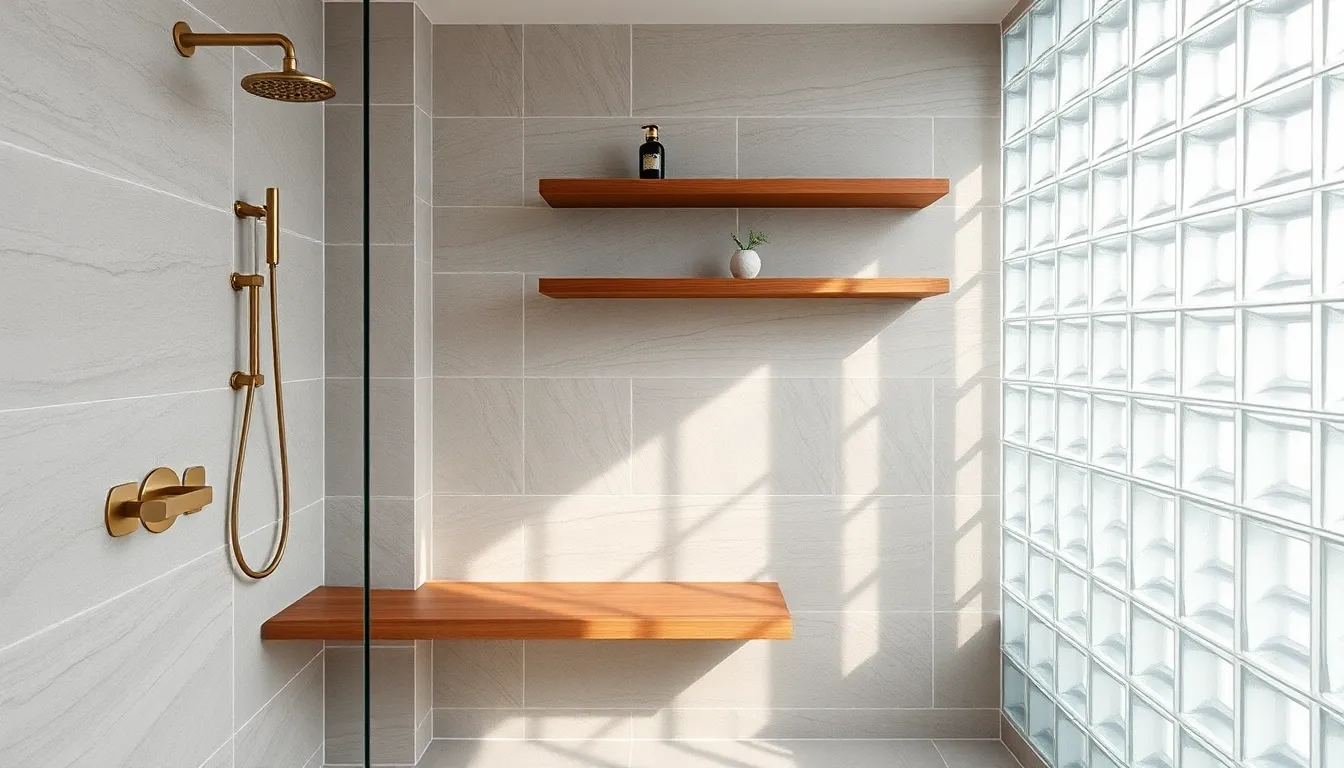
Transforming your shower into a design masterpiece becomes effortless when you combine different materials that complement each other perfectly. We’ll explore how contrasting textures and materials create depth while adding sophisticated visual interest to your space.
Tile and Wood Combinations
Wood accents bring warmth and natural elements that beautifully complement tile installations in shower environments. We recommend using teak or cedar wood elements as accent shelving, benches, or decorative strips against porcelain or ceramic tile backgrounds. These combinations work exceptionally well for creating cozy and inviting bathroom atmospheres that feel like personal retreats.
Strategic placement of wood accents includes installing floating shelves made from moisture resistant hardwood between tile sections. Waterproof wood treatments ensure longevity while maintaining the organic aesthetic that balances cool tile surfaces. Corner benches crafted from teak provide both functional seating and visual warmth against stark white subway tiles or sleek large format porcelain.
Metal Accent Integration
Metallic tiles and hardware additions bring modern sophistication and contemporary flair to traditional shower designs. We suggest incorporating brushed gold, matte black, or polished chrome accents through decorative tile borders, fixtures, and architectural elements. These metal touches create stunning focal points that elevate the entire shower experience.
Popular metal integration techniques include installing metallic mosaic strips as accent bands between neutral tiles. Stainless steel or brass corner guards protect tile edges while adding industrial elegance to the design. Chrome or bronze shower niches with metal frames create sophisticated storage answers that complement the overall material palette.
Glass Block Inserts
Glass block installations create modern and sleek appearances while allowing natural light penetration throughout the shower space. We find these translucent elements particularly effective for visually expanding smaller shower areas and creating privacy without sacrificing brightness. Contemporary glass blocks come in various textures and sizes to match different design aesthetics.
Installing glass block windows or accent walls transforms standard shower environments into bright, airy spaces that feel significantly larger. Frosted or textured glass blocks maintain privacy while diffusing natural light beautifully across tile surfaces. Strategic placement of these inserts includes creating feature walls, privacy screens, or decorative panels that complement your existing tile patterns and color schemes.
Budget-Friendly Design Solutions
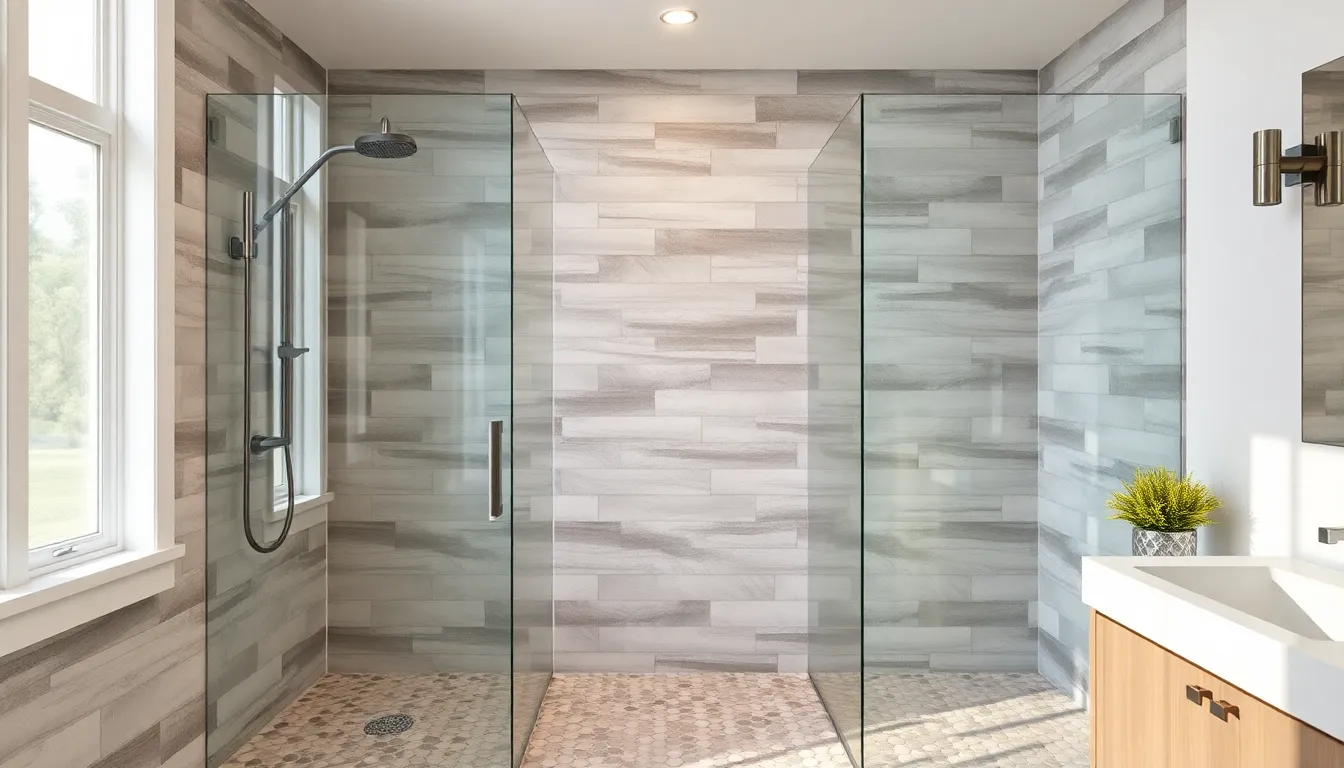
Creating a stunning shower doesn’t require very costly. We’ll show you how to achieve impressive results with smart material choices and strategic design decisions.
Ceramic Tile Alternatives
Porcelain tiles offer exceptional durability while mimicking expensive materials like natural stone and hardwood at a fraction of the cost. These versatile tiles resist moisture and stains better than traditional ceramic options, making them perfect for high-humidity shower environments.
Natural stone look tiles provide the authentic appearance of marble, travertine, or slate without the premium price tag. We recommend choosing porcelain versions that capture the organic veining and texture of natural materials while offering easier maintenance and installation.
Marble-look porcelain tile delivers the elegance of genuine marble without the ongoing upkeep requirements. These tiles capture the sophisticated patterns and color variations of Carrara or Calacatta marble while providing superior water resistance and durability for daily shower use.
DIY Installation Options
Adhesive-backed tiles eliminate the need for professional installation and messy grout mixing. These peel-and-stick options work exceptionally well for accent walls and smaller shower areas, reducing labor costs by up to 70% compared to traditional tile installation.
Self-adhesive tile mats provide another user-friendly installation method that doesn’t require specialized tools or experience. We suggest using these interlocking systems for mosaic patterns and smaller format tiles, which typically take weekend DIYers just 4-6 hours to complete.
Simplified grid patterns reduce cutting requirements and minimize material waste during installation. Straight-line layouts and basic brick patterns require fewer precision cuts, making them ideal for first-time tile installers while maintaining professional-looking results.
Cost-Effective Pattern Ideas
Simple subway pattern creates a timeless, minimalist look using affordable white or neutral-colored tiles in traditional horizontal arrangements. This classic layout requires minimal cutting and waste, making it perfect for budget-conscious renovations while delivering enduring style.
Herringbone pattern adds sophisticated visual interest without requiring expensive specialty tiles. We recommend using standard rectangular tiles in a zigzag arrangement to create ever-changing movement and texture that elevates the overall design impact.
Geometric patterns transform basic square or rectangular tiles into striking focal points through creative arrangement. Simple diamond layouts, checkerboard designs, and alternating color schemes create dramatic visual effects while using budget-friendly materials throughout the shower space.
Pebble tiles bring organic, spa-inspired ambiance to shower floors and accent walls while providing natural slip resistance. These affordable natural stone options create tactile interest and soothing visual texture that enhances the overall bathing experience.
Glass mosaic tiles offer modern, reflective surfaces that make small shower spaces feel larger and brighter. Strategic placement in niches, accent strips, or feature walls maximizes their visual impact while keeping costs manageable through selective application.
Maintenance Considerations for Long-Term Beauty
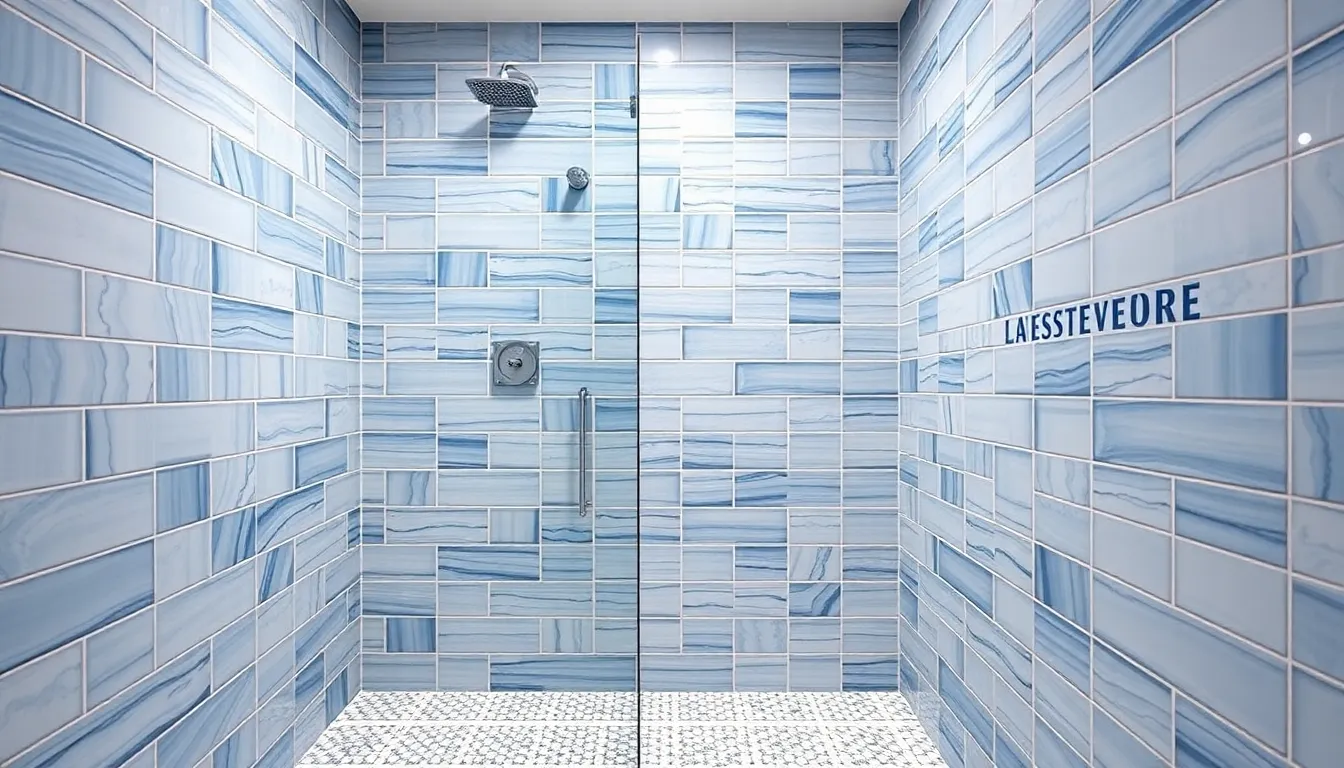
Selecting the right maintenance approach ensures your shower tile investment continues to deliver stunning results for years to come. We’ll explore the essential factors that preserve both beauty and functionality in your shower space.
Grout Selection and Sealing
Epoxy grout stands as the superior choice for shower installations, offering exceptional durability and waterproof protection that eliminates ongoing sealing requirements. This advanced material creates a permanent barrier against moisture penetration while maintaining its original appearance over time.
Traditional cement grout requires regular sealing every 6-12 months to prevent water damage and staining in high-moisture environments. Consider applying penetrating sealers that protect without altering the grout’s natural appearance.
Color-matched grout minimizes maintenance visibility by concealing minor staining and wear patterns that naturally occur in shower environments. Choose darker grout tones for areas prone to soap residue and lighter shades for spaces where mineral deposits are common.
Cleaning and Care Requirements
Regular cleaning with mild soap and water proves sufficient for most tile installations, maintaining both appearance and hygiene without damaging surfaces or finishes. Perform weekly cleaning sessions to prevent buildup of soap scum and mineral deposits.
Avoid abrasive cleaners and scrubbing tools that can scratch tile surfaces or damage protective glazes on ceramic and porcelain materials. Use soft cloths or non-abrasive sponges for routine maintenance tasks.
Natural cleaning answers like white vinegar and baking soda effectively remove mineral deposits and soap buildup without introducing harsh chemicals into your shower environment. Mix equal parts water and vinegar for weekly deep cleaning sessions.
Glass tiles require more frequent attention due to visible water spots and soap residue that accumulate along grout lines and tile surfaces.
Durability Factor Comparisons
| Tile Material | Water Absorption Rate | Scratch Resistance | Maintenance Level |
|---|---|---|---|
| Ceramic | Low absorption rate | Moderate resistance | Low maintenance |
| Porcelain | Lower than ceramic | Higher than ceramic | Low maintenance |
| Glass | Non-porous | Moderate resistance | High maintenance |
Ceramic tiles deliver excellent water resistance and durability, making them ideal choices for shower installations where moisture protection is paramount. Their low absorption rates prevent water penetration and reduce the risk of structural damage over time.
Porcelain tiles offer enhanced scratch resistance compared to ceramic options, providing superior durability for high-traffic shower areas and family bathrooms. This material maintains its appearance longer under heavy use conditions.
Glass tiles create sparkling visual effects but demand more frequent cleaning attention due to visible water spots and soap residue accumulation along grout lines.
Conclusion
Transforming your shower space doesn’t have to be overwhelming when you have the right design roadmap. We’ve explored countless options that prove beautiful tile work is achievable regardless of your budget or bathroom size.
From timeless subway patterns to striking geometric designs every style preference has a perfect match. The key lies in balancing aesthetics with functionality while considering long-term maintenance needs.
Whether you’re drawn to luxurious natural stone or prefer budget-friendly ceramic alternatives your dream shower is within reach. Remember that proper installation and quality materials will ensure your investment stands the test of time.
Your bathroom deserves to be a personal sanctuary that reflects your unique style. With these design ideas and practical tips you’re ready to create a shower space that elevates your daily routine for years to come.
Frequently Asked Questions
What are the most popular shower tile designs?
The most popular shower tile designs include classic subway tiles in horizontal, vertical, or herringbone patterns, bold geometric designs like hexagonal shapes, natural stone options such as marble and travertine, large format tiles for seamless surfaces, and mosaic combinations. These designs offer versatility for any bathroom style and budget.
How do I choose the right tile color scheme for my shower?
Consider three main approaches: monochromatic palettes for a clean, cohesive look; bold contrasts to create dramatic focal points; or earthy tones for a natural, spa-like atmosphere. Your choice should complement your bathroom’s existing design and the mood you want to create.
Are natural stone tiles suitable for shower walls?
Yes, natural stone tiles like marble, travertine, and slate are excellent for shower walls. They provide luxury appeal and durability when properly sealed. However, they require regular maintenance and sealing to prevent water damage and staining, making them ideal for those willing to invest in upkeep.
What are budget-friendly alternatives to expensive shower tiles?
Ceramic tiles offer an affordable alternative to natural stone while mimicking premium looks. DIY installation can significantly reduce costs, and choosing larger format tiles requires fewer grout lines, reducing labor time. Mixing expensive accent tiles with budget-friendly field tiles also creates visual impact affordably.
How do I maintain different types of shower tiles?
Maintenance varies by material: ceramic and porcelain need regular cleaning with mild detergents; natural stone requires sealing every 1-2 years and pH-neutral cleaners; glass tiles need frequent cleaning to prevent water spots. Use epoxy grout for better durability and easier maintenance across all tile types.
What size tiles work best in small showers?
Large format tiles work surprisingly well in small showers as they create fewer grout lines, making the space appear larger and more seamless. However, smaller mosaic tiles can add texture and visual interest. Avoid medium-sized tiles that can make small spaces feel cramped and busy.
Can I mix different tile materials in one shower?
Absolutely! Mixing materials creates visual interest and unique design elements. Popular combinations include pairing natural stone with glass accents, combining textured and smooth tiles, or using different materials for accent walls versus field areas. Ensure materials have similar maintenance requirements for best results.
What type of grout is best for shower installations?
Epoxy grout is the superior choice for showers due to its waterproof properties, stain resistance, and durability. While more expensive than traditional cement grout, it requires less maintenance and provides better long-term protection against moisture damage and discoloration in wet environments.
